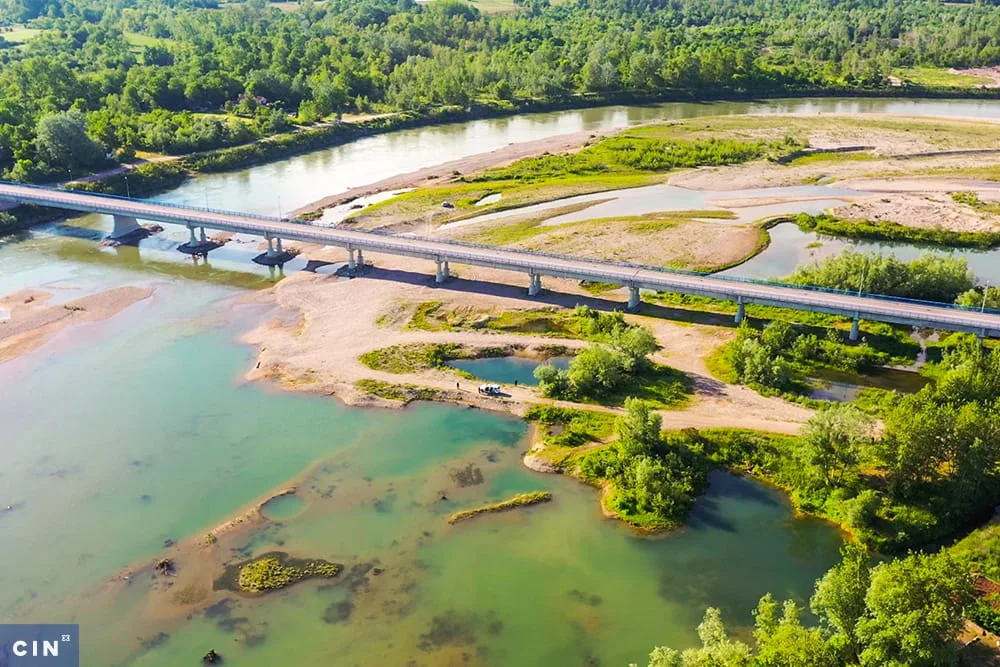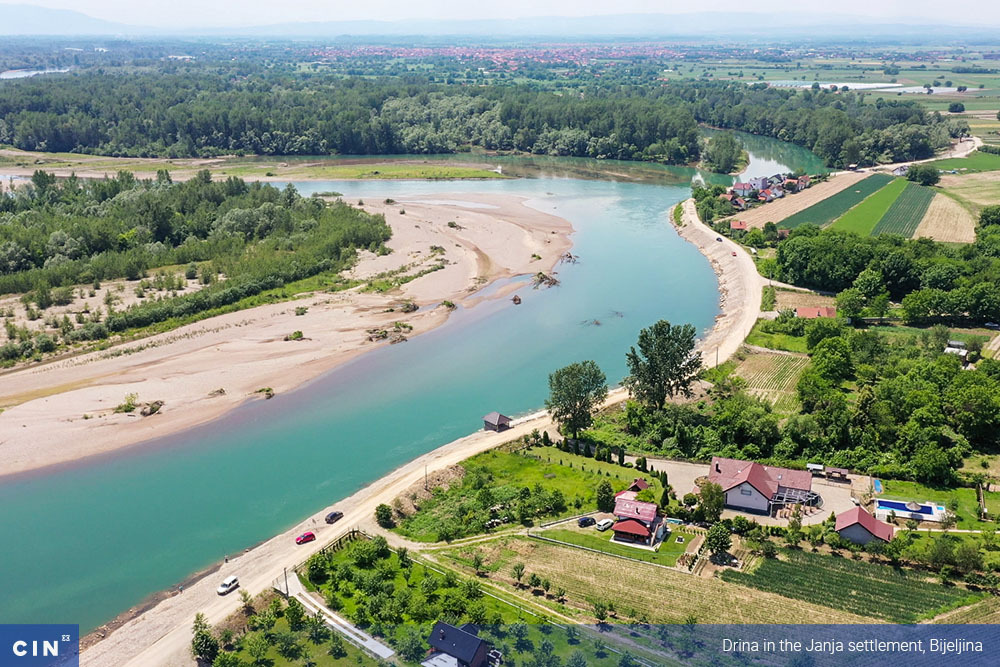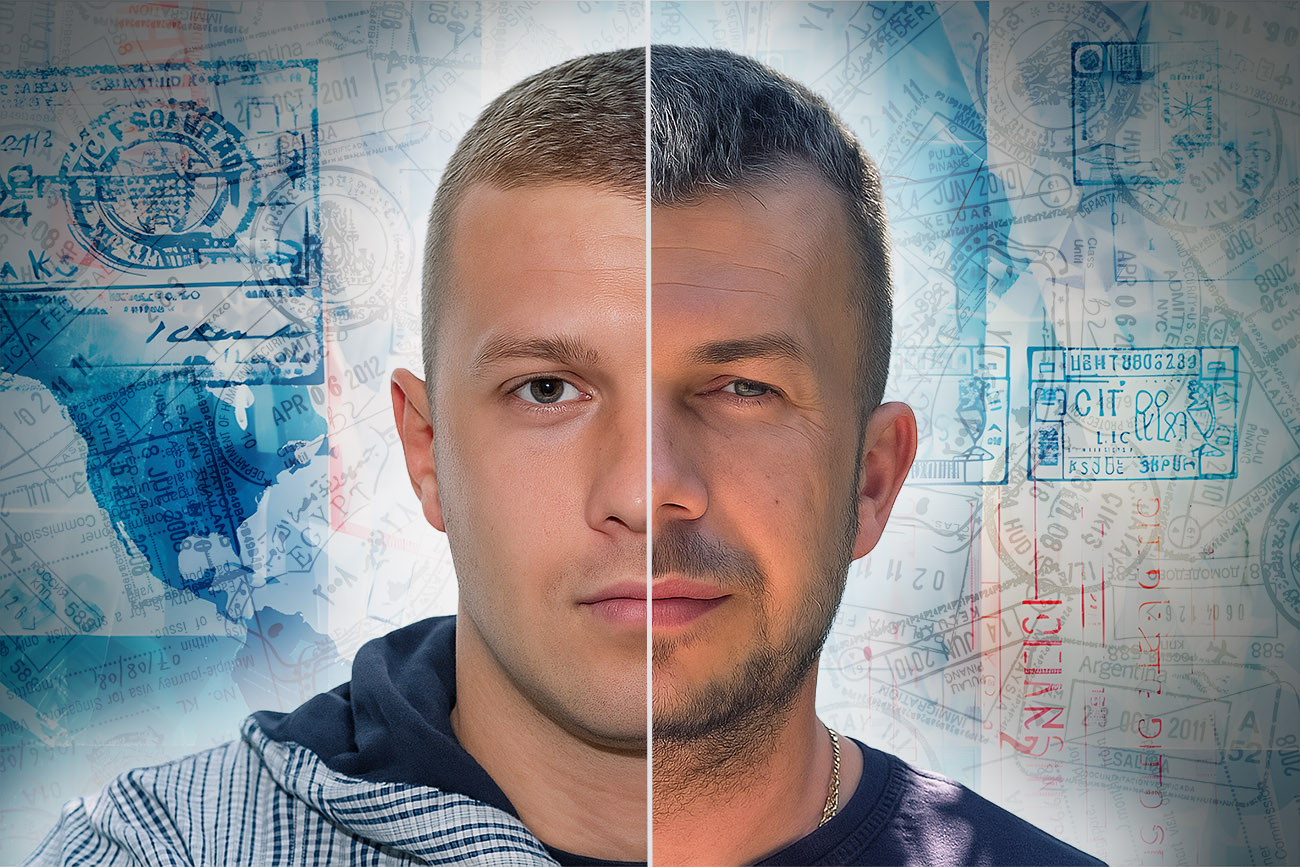A sign indicating the entry into the territory of Serbia is seated between Bijeljina and the border crossing point with Serbia. It was placed by a Serbian politician, Živan Jakšić, who crosses the border every day to illegally mine the gravel from the banks of the river Drina. Although within Bosnia and Herzegovina (BiH), hectares of Jakšić’s land belongs to Serbia.
For 25 years, the two countries have not been able to agree on a demarcation line, so the Drina river is considered the border. But the Drina river is moving, thus causing problems. Due to large deposits of gravel in the riverbed, the river spills on the left or right side, thus making a new riverbed and leaving 700 hectares of Bosnian territory in Serbia and 2,900 hectares of Serbian territory in BiH.
Next to Jakšić’s estate is the gravel pit of DMS Company run by a Bosnian politician, Milan Dakić. His company is in BiH, and he is digging gravel illegally some twenty meters away, in Serbian territory, on the same bank of the river Drina.
Don't want to miss our stories?
Sign up for our newsletter.
Don't want to miss our stories?
Sign up for our newsletter.
Both elected by citizens to work for the public good, but they took advantage of the lack of control in this area to make money illegally.
To protect Semberija from flooding, gravel must be extracted from the riverbed, not from the river banks, as the gravel-miners currently do illegally. By digging up the banks, they render the river Drina flood the fertile lands of Semberija.
“Because of that wild exploitation of gravel, a very small number of people take it from the riverbed, the Drina is not cleaned”, says Mićo Mićić, the Mayor of Bijeljina.
The last floods of 2014, caused damage to the population of Bijeljina of almost 400 million marks.
Politics and business
Milan Dakić has been a deputy in the National Assembly of Republika Srpska on behalf of the Democratic Alliance (DEMOS) for six years but has never taken part in the parliamentary debate. Nevertheless, he does not give up politics, so this year he is the first candidate on the electoral list for the Municipal Assembly of Bijeljina. In Semberija, he is known as a graver-miner. His company was dealing solely with fruits and vegetable production until 2013, when Dakić, owing to major construction projects announcements i.e. construction of a motorway and a bypass around Bijeljina, decided to engage in gravel mining. Although it is him who runs the business, the company is formally owned by his mother.
“Due to my determination to get into politics, the company represented a problem in that politics. I had to resolve it. If I wanted to be involved in politics, I had to get rid of the company”, Dakić told CIN.
This is how he avoided a conflict of interest because his DMS Company works with public companies and institutions. If he had stayed a formal owner on the paper, he would have not been allowed to do so.
His company is on the very border of “no man’s land”, on a plot listed in the cadastral books as the last one along the border with Serbia.
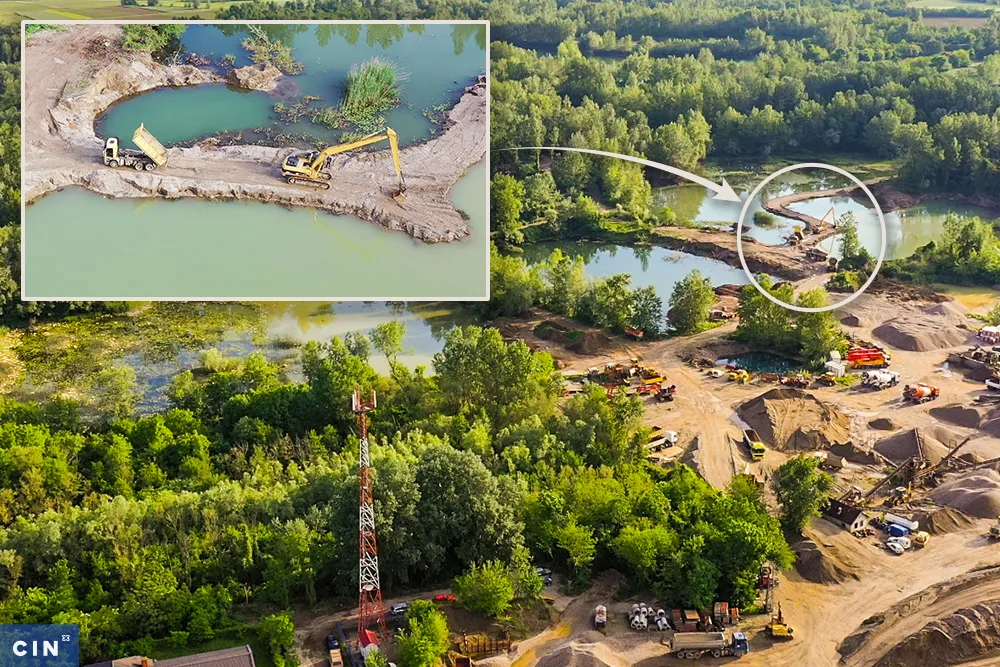

That borderline was drawn more than 130 years ago while the Drina flowed along the edge of the plot, but the river has changed its course many times since. Today, it is more than three kilometres away from Dakić’s plot. The maps accepted by the Dayton Peace Agreement mark the borderline with Serbia on the river Drina, so the few kilometre wide belt of river land remained between the “cadastral” and “Dayton” borderlines. This is why inspection authorities from both countries mostly circumvent this territory. This is where deputy Dakić excavates the gravel from, which he then deposits in his parcel in BiH. He denies this, despite CIN journalists finding at the site of his company the machinery that had previously been illegally excavating the gravel.
“My company did not dig where you took pictures. Luckily for me! I’m telling you to your face. Luckily for me, it did not dig”, claims Dakić.
When the journalist asked about the gravel stocks piled around the company, he claimed these to be the quantities he had legally extracted in previous years from the river Drina in the place called Međaši. He claims to have permits issued by Vode Srpske, public Institution responsible for waters in Republika Srpska. “And do you know how much? Each was 100 thousand cubic meters because we all fight to get the maximum.”
CIN journalists found out this not to be true.
According to the data of the Vode Srpske, DMS Company last time legally extracted 24,700 cubic meters of gravel from the river Drina, in place Janja, in 2014. Although without a permit, by mid-2018 the company sold 41,000 cubic meters of gravel in excess of the 24,700 cubic meters of legally extracted gravel.
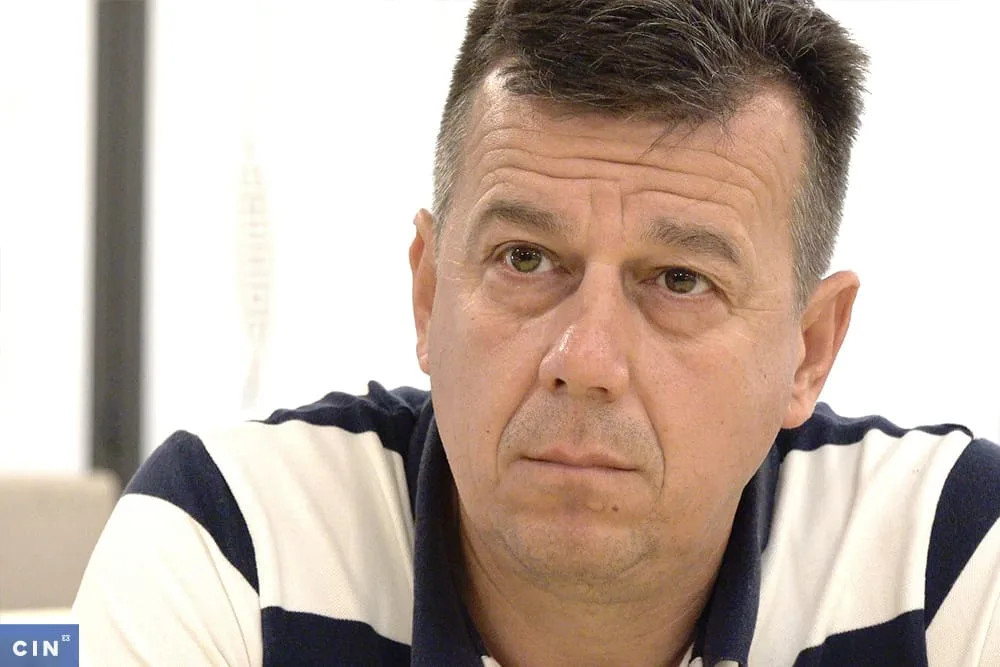
Faced with the truth about the permits, Dakić admitted that he was wrong. He attempted to shift the liability for illegal exploitation to workers.
Unlike the explanation the deputy offered to the journalists, the inspection authority visiting the company received a completely different explanation about the origin of the gravel they sold. Market inspectors of Republika Srpska noted in their minutes that DMS Company in the period from 2017 until the mid-2018 bought gravel from company Meljnik RS from Bijeljina, and in 2019 from the company TOP-TIM gradnja from Brčko.
Slađan Čvrgić, the director and only employee of TOP-TIM gradnja claims to have never sold any gravel to Dakić. “I have nothing to do with gravel”, says Čvrgić. His company has never had a permit for the exploitation of gravel, and Čvrgić says that he deals with the import of second-hand cars.
Vera Petrić, the owner of the Bijeljina company Meljnik RS, told CIN journalist to have been selling gravel to Dakić, but she did not give information as to the time and volumes delivered.
Last year, Dakić’s company was re-granted a permit for gravel extraction and cleaning of the Drina river in Janja, a place five kilometres away from the company’s depository, but until the middle of this year, they did not do any mining there.
Watch it and weep
The competence of Republika Srpska inspectors on “no man’s land” is not legally regulated, so they do not control a piece of BiH land on the right bank. “The internationally recognized borderline is the river Drina, and, from that point of view, it is a different country to us”, says Dušanka Makivić, RS Inspectorate spokeswoman.
Serbian inspectors also seldom visit the part under their competence on the left bank in BiH. In the last five years, municipal and communal inspectors have not been to this place once.
“You know how much an inspector from Šabac or Badovinac cares if someone is building a landfill, and it is their territory. He does not care about this side of the river Drina”, says Ratomir Draganić, the Chief of the Communal Police in Bijeljina.
Water inspectors could work on both sides of the river in joint controls, as Republika Srpska and Serbia have an Integrated Water Management Cooperation Agreement for the Lower Drina River, but they rarely do so.
The last time they visited the border crossing point on Pavlovića most was in 2018. There, they found Živan Jakšić Žića, a former councillor of the Socialist Party in the Municipal Assembly of Bogatić, Serbia, stealing gravel from the left bank of the Drina river in BiH. Although ordered to stop digging immediately, Jakšić continued his operations.
Two years later, CIN journalists found him there doing the same operations. He has not had an exploitation permit for five years, but he is still operating.
“I guarantee that every one of these people – who work best – wants to get a permit and work properly, but the procedure is so difficult and sometimes very discouraging”, says the former long-time municipal councillor.
Even in a ripe age and leaning on a cane, he still daily crosses the border on the Pavlovića most using a farmer pass to dig gravel in BiH. His brothers and he have several hundred hectares of land there, which the states have not yet finally agreed whom they belong to. There is located company IM Jakšić, formally owned by Miloš Jakšić, Žica’s nephew. However, it is this politician who runs the business, claiming that the gravel pit is his. Work is in full swing here – in less than an hour, a dozen trucks of material were taken from the shore where the gravel was being dug.
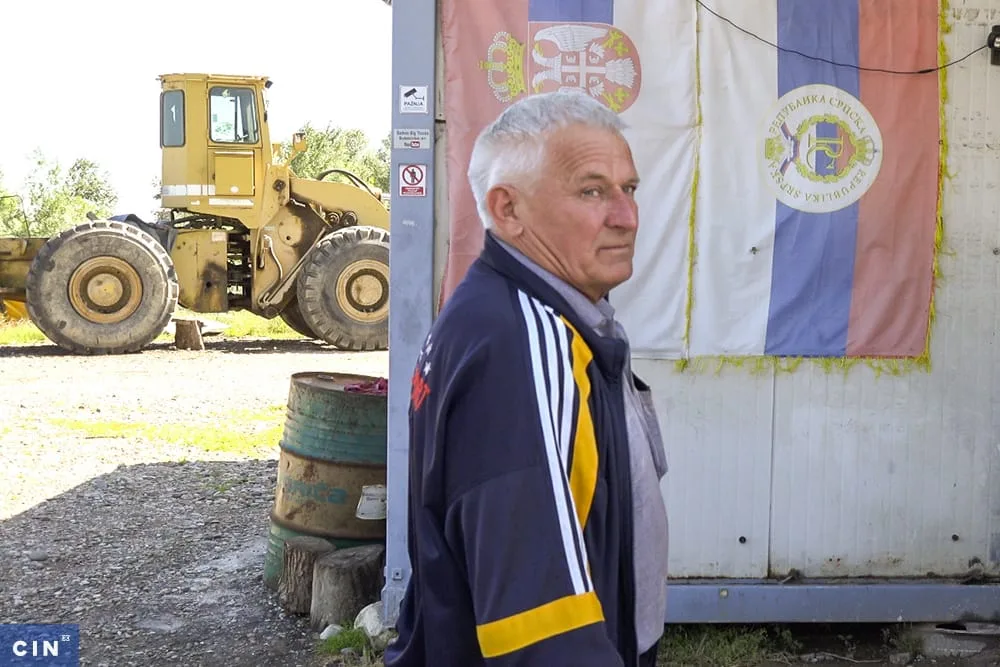
Without any apparent embarrassment for being caught red-handed in illegal activity, he explained to the journalists the borders of the occupied territory along the Drina. “This was Despotić’s, and this was Buk’s, and this was mine (…) No, nothing grows here, only that rock.”
Any digging on the river banks, let alone uncontrolled digging of gravel, is prohibited in both Serbia and BiH because it increases the risk of banks collapsing and flooding of settlements. Water companies grant permits for the exploitation of gravel and sand from the riverbed only, to clear the way for the free flow of water.
For this job, they hire companies through a public call, which must pay for the issuance of documentation and a fee for each cubic meter of extracted material. In this part of BiH, at least a mark and a half are paid for that, while in Serbia it is twice as cheap.
For years, Žića has been backfilling the excavated pits with communal and other waste that Bijeljina citizens throw into wild dumps along the river. All the way down the road there are piles of garbage, old furniture, tires, construction debris, and waste that cannot be disposed of in the landfill. Some cannot be approached because of the stench.
Waste backfilling is one of the most dangerous consequences of illegal exploitation of gravel. “It can permanently degrade the quality of groundwater, and that is very dangerous”, says geologist Branko Ivanković, explaining that such polluted water enters the drinking water reservoirs and can have serious consequences for the health of the population.
Although the dumping of waste on the shores is prohibited, Jakšić is convinced that by accumulating construction debris on the shores, he is protecting the shores from collapsing. “The inspector comes often, and says well done”, he bragged to CIN journalists.
The impressions of an inspector operating in the border zone over the past couple of years are quite different from what Jakšić claims. The Chief of the Bijeljina Communal Police, Ratomir Draganić, recalls the former rich politician setting on fire the tires brought to him by tire fitters, and the Bosnian inspectors not being able to do anything about it. “A man set fire on his own land, the territory of Serbia. All we could do was to watch it and weep.”
A bottleneck
The working groups for the border between Serbia and BiH have not met for 10 years. Previously, the Serbian side requested that before signing the documents on the border, the cadastral line be changed in four places: around the HPP Zvornik and HPP Bajina Bašta, the Belgrade-Bar railway, and part of the Municipality of Rudo. BiH rejected the request, demanding that the border be determined first, and nothing has changed since.
“We cannot accommodate these requests. We are asking for a border agreement to be concluded (…) and then, in the interest of both countries, we can start talks and negotiations on some border issues”, said BiH Presidency member Šefik Džaferović.
Veljko Odalović, the chair of the Border Commission responsible for negotiations on behalf of Serbia, insists that all disputed points be resolved before the final confirmation of the border. But this will not happen unless the talks are opened. “This way we will not solve anything. You will continue to receive different information, people will be confused, inspection and other services, of course, will be powerless”, Odalović says for CIN.
The “bottlenecks” of the Drina, i.e. the points where the river most often overflows and floods in Bosnia and Herzegovina are located in Serbia. As nearly 3,000 hectares of land is beyond the remit of Vode Srpske, they cannot hire domestic companies to clean that part of the riverbed. Due to high transport costs, companies from Serbia do not find these locations profitable, hence the river Drina remains full of gravel and as such poses a constant risk of flooding.
Miroslav Milovanović, director of Vode Srpske, claims to have invited his colleagues from the Serbian water management company Srbijavode to sign an agreement under which Serbia would take care of the right bank and Republika Srpska of the left bank of the Drina river.
“Our colleagues from the Serbian Ministry and the Water Directorate are very cautious in that sense due to the interstate relations between Serbia and Bosnia and Herzegovina. They do not want to disrupt some relations at that, i.e. highest interstate level”, says Milovanović.
And at the highest level, there is almost no discussion about resolving the border issue.
BiH and Serbian working groups have been trying to solve this problem since 1996, without success. They have met only a few times since, and they have never discussed the territory in which the Drina river is moving from one bank to another and the problems that the residents of the border municipalities have because of that.
Until an agreement is reached, the border is mostly the Drina river. The people of Semberija are increasingly calling it wild and untamed because of the enormous damage it inflicts on the fertile plain. Semberija is bordered by the Sava and Drina, and Una, Vrbas, Bosna, Bistrica, Janja, and many other BiH rivers flow into them. All that water flows through the Bijeljina area.
The 2014 floods ravaged the city leaving damage of almost 400 million marks. Many Semberija people who grew up on the rivers say they no longer view them the same way. Turning a blind eye to the consequences of illegal gravel exploitation, they blame nature for the disaster.
“When the water hit in 2014, I swore never to swim in it again. Here, it has been six years since – I never went [swimming there]”, says Blagomir Burić from the Bijeljina village of Popovi.
Mićo Mićić, Mayor of Bijeljina, knows that the Drina is not to blame for the floods. “The major problem with the Drina and the Sava, in Bosnia and elsewhere, is that the riverbeds are not cleaned (…) Either the embankment must be erected or the riverbeds must be cleaned. That’s the way it is with the Drina.”
Although extracting several millions of cubic meters of gravel from the riverbed would reduce the risk of floods, and earn profit to the budget, the Entity and city authorities spend millions of marks a year on the bank revetments and embankments.
The construction of the Drina embankment is to start early next year. The plan is to build a 32-kilometer long embankment, and the first two kilometres will cost three million marks.



